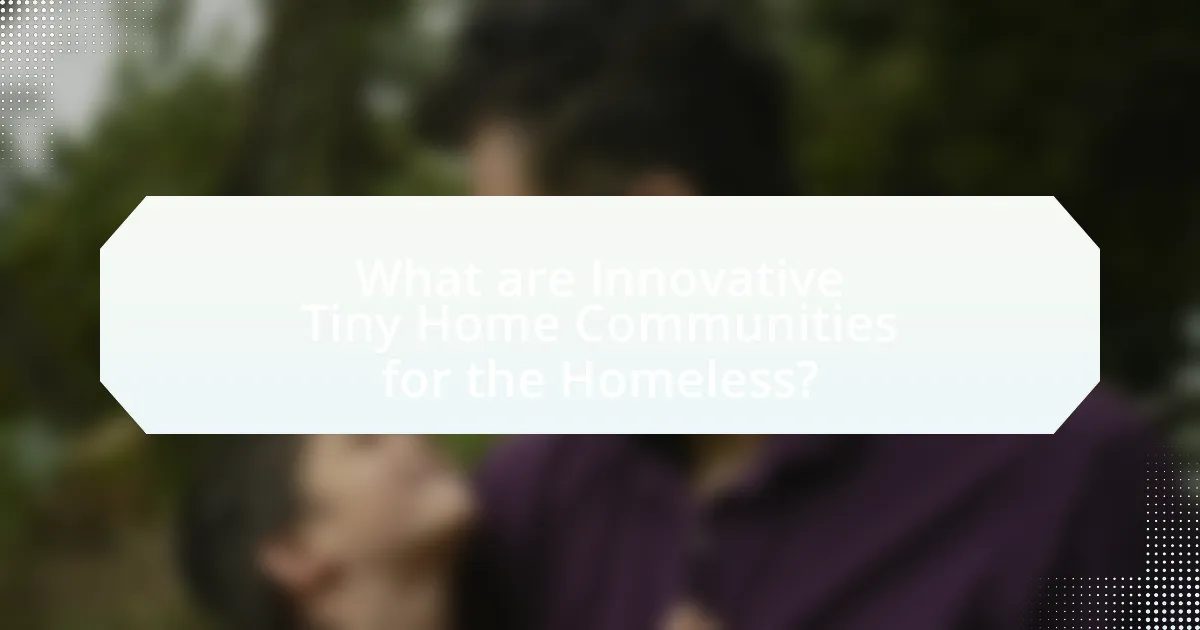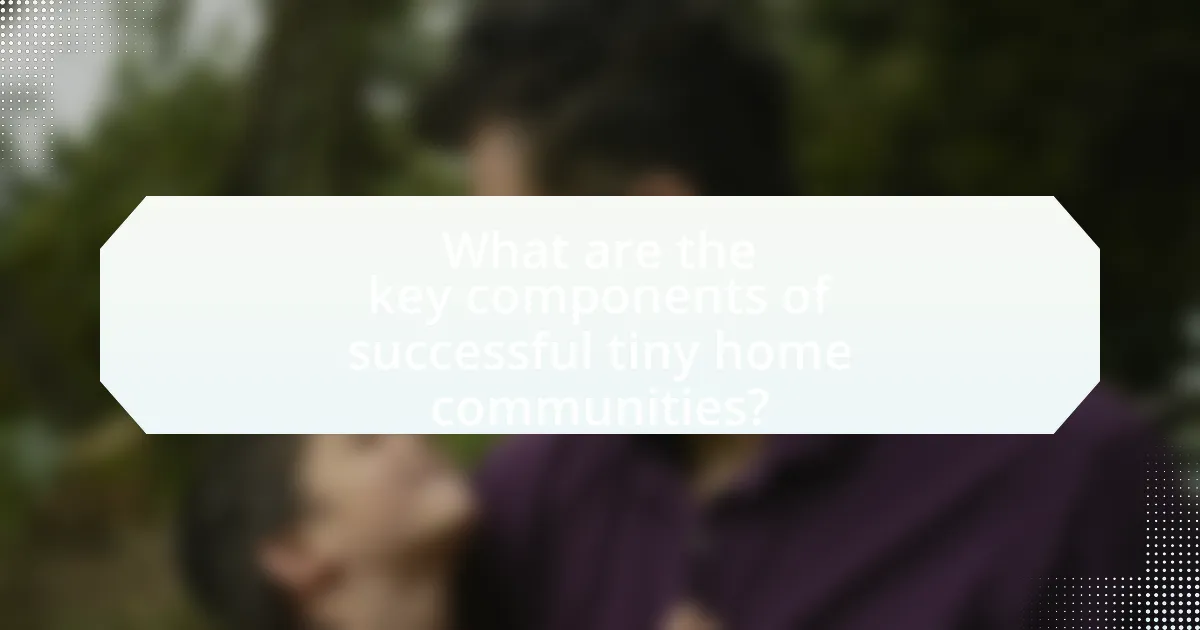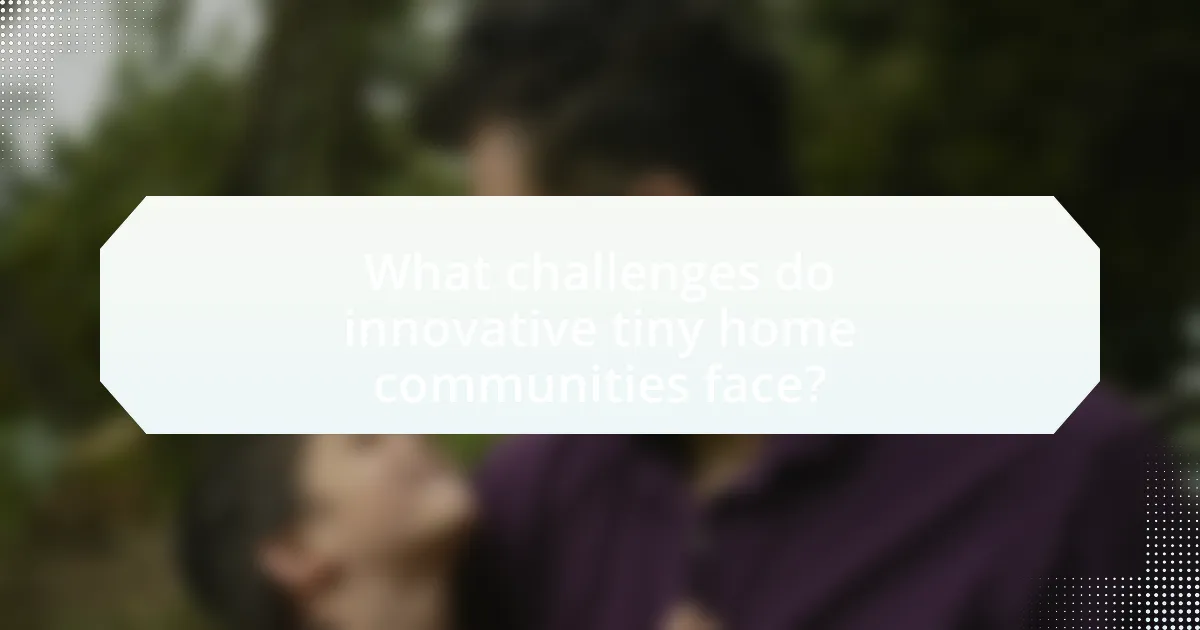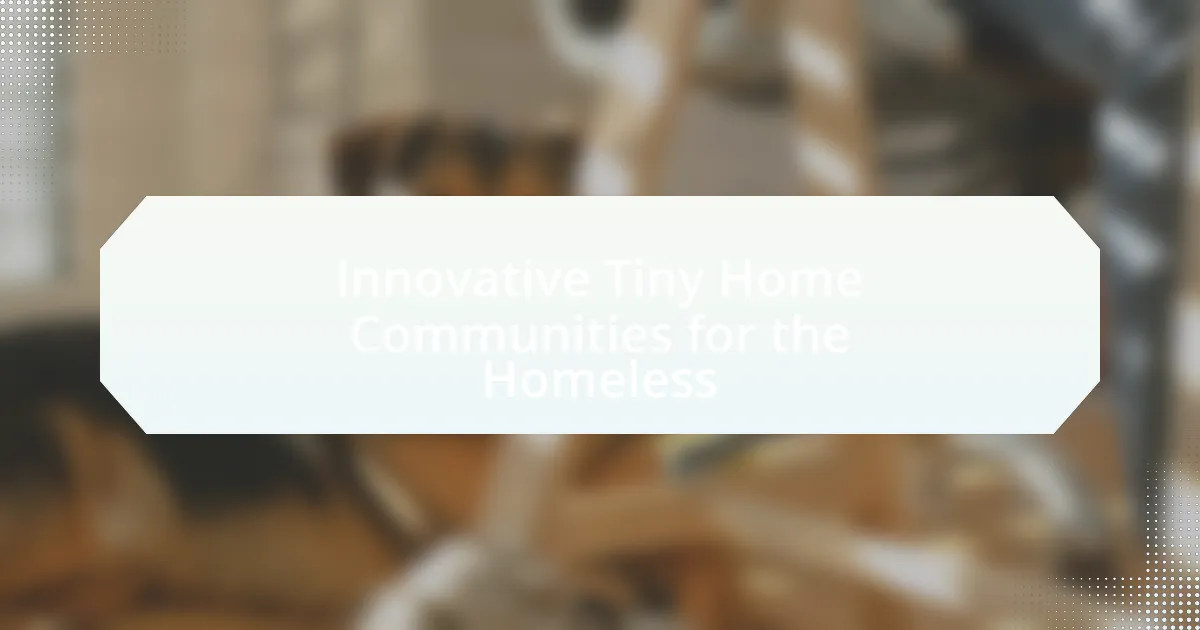Innovative tiny home communities for the homeless are organized living spaces that provide small, affordable housing units aimed at addressing homelessness. These communities differ from traditional shelters by offering individual, self-contained units that promote autonomy and stability, along with shared resources and supportive services. Key components of successful tiny home communities include effective planning, community engagement, and sustainable infrastructure, while challenges such as zoning regulations and funding limitations can hinder their establishment. Research indicates that these communities can significantly reduce homelessness and improve residents’ quality of life through integrated support services and a sense of belonging.

What are Innovative Tiny Home Communities for the Homeless?
Innovative tiny home communities for the homeless are organized living spaces that provide small, affordable housing units specifically designed to address homelessness. These communities often feature a collection of tiny homes, shared facilities, and supportive services aimed at helping residents transition to stable living conditions. For example, the Community First! Village in Austin, Texas, offers tiny homes along with access to healthcare, job training, and social services, demonstrating a successful model for integrating homeless individuals into supportive environments. Such initiatives have been shown to reduce homelessness and improve quality of life, as evidenced by studies indicating that permanent housing solutions significantly decrease the rates of chronic homelessness.
How do these communities differ from traditional shelters?
Innovative tiny home communities differ from traditional shelters primarily in their approach to housing stability and community integration. While traditional shelters often provide temporary, communal living arrangements with limited privacy and personal space, tiny home communities offer individual, self-contained units that promote autonomy and a sense of ownership. This model fosters a supportive environment where residents can establish a stable living situation, as evidenced by studies showing that permanent supportive housing reduces homelessness more effectively than temporary shelters. Additionally, tiny home communities often incorporate shared resources and communal spaces, encouraging social interaction and collaboration among residents, which contrasts with the more isolated experience typically found in traditional shelters.
What unique features do tiny homes offer for homeless individuals?
Tiny homes provide homeless individuals with secure, affordable, and manageable living spaces that promote stability and community. These homes typically range from 100 to 400 square feet, making them cost-effective and easier to maintain than traditional housing. Additionally, tiny home communities often include shared resources such as communal kitchens, bathrooms, and social services, fostering a sense of community and support among residents. Research indicates that such environments can lead to improved mental health and social connections, as seen in projects like the Community First! Village in Austin, Texas, which has successfully housed over 200 formerly homeless individuals since its inception.
How do community designs promote social interaction and support?
Community designs promote social interaction and support by creating shared spaces that encourage engagement among residents. These designs often include communal areas such as gardens, kitchens, and recreational facilities, which facilitate gatherings and foster relationships. For instance, research conducted by the University of California found that communal living arrangements significantly increase social ties and reduce feelings of isolation among residents. Additionally, the layout of tiny home communities can be strategically planned to enhance visibility and accessibility, further promoting interaction. Such environments not only provide physical shelter but also cultivate a sense of belonging and mutual support, essential for the well-being of individuals experiencing homelessness.
Why are tiny home communities considered a solution for homelessness?
Tiny home communities are considered a solution for homelessness because they provide affordable, stable housing options that can be quickly deployed. These communities typically consist of small, efficient homes that reduce living costs, making them accessible to individuals experiencing homelessness. For example, a study by the National Alliance to End Homelessness found that tiny home projects can be built at a fraction of the cost of traditional housing, often under $30,000 per unit. Additionally, tiny home communities foster a sense of community and support among residents, which can lead to improved mental health and social stability. This model has been successfully implemented in various cities, demonstrating its effectiveness in addressing homelessness.
What statistics support the effectiveness of tiny home communities?
Tiny home communities have shown effectiveness in addressing homelessness, with studies indicating a 60% reduction in emergency room visits among residents. Research conducted by the University of Utah found that participants in tiny home villages experienced improved mental health and stability, with 80% of residents maintaining housing after one year. Additionally, a report from the National Alliance to End Homelessness highlighted that tiny home communities can reduce costs associated with homelessness by up to 50%, as they provide stable housing and support services. These statistics demonstrate the positive impact of tiny home communities on individuals experiencing homelessness.
How do these communities address the root causes of homelessness?
Innovative tiny home communities address the root causes of homelessness by providing stable, affordable housing and supportive services. These communities often incorporate on-site resources such as job training, mental health support, and substance abuse counseling, which directly tackle issues that contribute to homelessness. For instance, studies have shown that stable housing significantly improves individuals’ ability to secure employment and access healthcare, thereby reducing the likelihood of returning to homelessness. Additionally, the design of tiny home communities fosters a sense of community and belonging, which can mitigate social isolation, a common factor in homelessness.

What are the key components of successful tiny home communities?
Successful tiny home communities are characterized by effective planning, strong community engagement, and sustainable infrastructure. Effective planning involves zoning regulations that support tiny home development and access to essential services such as water, electricity, and waste management. Strong community engagement fosters a sense of belonging and collaboration among residents, which is crucial for social cohesion. Sustainable infrastructure includes environmentally friendly building materials and energy-efficient designs, contributing to long-term viability. Research indicates that communities with these components experience higher resident satisfaction and lower turnover rates, reinforcing the importance of these elements in creating successful tiny home environments.
How is land acquisition managed for these communities?
Land acquisition for innovative tiny home communities for the homeless is typically managed through partnerships between local governments, non-profit organizations, and community stakeholders. These entities collaborate to identify suitable parcels of land that can be repurposed for housing, often utilizing zoning laws and land use regulations to facilitate the process. For instance, cities may offer surplus public land or incentivize private landowners to donate or lease land at reduced rates, thereby lowering costs and expediting development. Additionally, funding sources such as grants and public financing are often secured to support the acquisition and development of these properties, ensuring that the communities can be established sustainably and effectively.
What zoning laws impact the establishment of tiny home communities?
Zoning laws significantly impact the establishment of tiny home communities by dictating land use, density, and building regulations. These laws can vary widely by municipality, often requiring tiny homes to meet specific criteria such as minimum square footage, utility connections, and compliance with local building codes. For instance, some areas may classify tiny homes as accessory dwelling units (ADUs), which can influence their legality and placement on residential lots. Additionally, zoning regulations may restrict the location of tiny home communities to certain zones, such as residential or mixed-use areas, thereby affecting their accessibility and integration within the community.
How do partnerships with local governments facilitate development?
Partnerships with local governments facilitate development by providing essential resources, regulatory support, and community engagement necessary for projects like innovative tiny home communities for the homeless. Local governments can offer funding, land, and infrastructure improvements, which are critical for establishing these communities. For instance, in 2020, the city of Austin, Texas, collaborated with local nonprofits to create tiny home villages, demonstrating how government support can streamline zoning processes and expedite permits, ultimately leading to faster project implementation. This collaboration not only addresses homelessness but also fosters community acceptance and participation, enhancing the overall effectiveness of development initiatives.
What role do community services play in these environments?
Community services play a crucial role in innovative tiny home communities for the homeless by providing essential support and resources that facilitate successful transitions to stable living conditions. These services include access to healthcare, job training, and social support, which are vital for addressing the multifaceted needs of individuals experiencing homelessness. For instance, studies show that communities with integrated support services see higher rates of housing retention and improved overall well-being among residents. By fostering a sense of community and belonging, these services also enhance social cohesion, which is critical for long-term success in overcoming homelessness.
How do support services enhance the living experience for residents?
Support services enhance the living experience for residents by providing essential resources and assistance that promote stability and well-being. These services include access to healthcare, job training, and mental health support, which collectively address the diverse needs of individuals living in tiny home communities. For instance, studies show that residents who receive case management and social services report higher levels of satisfaction and improved quality of life, as they are better equipped to navigate challenges and achieve personal goals. Additionally, the presence of support services fosters a sense of community and belonging, which is crucial for individuals transitioning out of homelessness.
What types of services are typically offered in tiny home communities?
Tiny home communities typically offer a range of services designed to support residents, including access to utilities, communal spaces, and social services. Utilities often include water, electricity, and waste management, ensuring basic living conditions. Communal spaces may consist of kitchens, bathrooms, and recreational areas, fostering community interaction. Additionally, social services such as job training, mental health support, and financial counseling are frequently provided to assist residents in achieving stability and self-sufficiency. These services are essential for creating a supportive environment that addresses the needs of individuals experiencing homelessness.

What challenges do innovative tiny home communities face?
Innovative tiny home communities face significant challenges, including zoning regulations, funding limitations, and community opposition. Zoning regulations often restrict the placement and construction of tiny homes, making it difficult for these communities to establish legally. Funding limitations hinder the development and sustainability of these projects, as many rely on grants or donations that may not be consistently available. Additionally, community opposition, sometimes referred to as NIMBYism (Not In My Backyard), can arise from local residents who may fear that tiny home communities will decrease property values or attract crime, further complicating the establishment of these innovative housing solutions.
How do funding and financial sustainability impact these projects?
Funding and financial sustainability are critical for the success of innovative tiny home communities for the homeless, as they directly influence project viability and long-term impact. Adequate funding ensures that initial construction, ongoing maintenance, and support services are financially covered, which is essential for creating safe and stable living environments. For instance, a study by the National Alliance to End Homelessness highlights that projects with secure funding sources, such as government grants or private investments, are more likely to succeed in providing stable housing solutions. Furthermore, financial sustainability allows these communities to operate without relying solely on fluctuating donations or short-term funding, thereby ensuring consistent support for residents. This stability is evidenced by the success of programs like the Community First! Village in Austin, Texas, which has maintained financial sustainability through a combination of funding sources, including social enterprises and community partnerships.
What are common sources of funding for tiny home initiatives?
Common sources of funding for tiny home initiatives include government grants, private donations, crowdfunding, and nonprofit organization support. Government grants often come from local, state, or federal programs aimed at addressing homelessness and affordable housing, such as the U.S. Department of Housing and Urban Development. Private donations can be sourced from individuals or businesses interested in social impact. Crowdfunding platforms like GoFundMe allow community members to contribute directly to specific projects. Nonprofit organizations frequently provide financial assistance or resources to support tiny home initiatives, leveraging their networks and expertise in housing solutions.
How can communities ensure long-term financial viability?
Communities can ensure long-term financial viability by establishing diverse funding sources, including grants, donations, and partnerships with local businesses. For instance, successful tiny home communities often leverage government grants aimed at affordable housing initiatives, which can cover initial setup costs. Additionally, creating partnerships with local businesses can provide ongoing financial support through sponsorships or in-kind donations, fostering a sustainable ecosystem. Research indicates that communities with multiple funding streams are more resilient; for example, a study by the Urban Institute found that diversified funding models significantly enhance the sustainability of housing projects.
What social and political obstacles do these communities encounter?
Innovative tiny home communities for the homeless encounter significant social and political obstacles, including zoning laws and community opposition. Zoning regulations often restrict the establishment of such communities, as they may not fit within existing land-use classifications, leading to legal challenges and delays in development. Additionally, community opposition, often fueled by NIMBY (Not In My Backyard) sentiments, can hinder the acceptance of these projects, as residents may fear potential decreases in property values or increased crime rates. Studies indicate that these obstacles can significantly impede the implementation of effective housing solutions for homeless populations, as seen in various case studies across the United States where proposed tiny home villages faced local resistance and regulatory hurdles.
How do public perceptions influence the success of tiny home projects?
Public perceptions significantly influence the success of tiny home projects by shaping community support, funding opportunities, and regulatory acceptance. Positive perceptions can lead to increased community engagement and advocacy, which are crucial for securing necessary permits and funding. For instance, a study by the University of California, Berkeley, found that communities with favorable views on affordable housing initiatives were more likely to support zoning changes and funding allocations for such projects. Conversely, negative perceptions can result in opposition, leading to delays or cancellations of tiny home developments. Therefore, the alignment of public perception with the goals of tiny home projects is essential for their successful implementation and sustainability.
What advocacy efforts are necessary to support tiny home communities?
Advocacy efforts necessary to support tiny home communities include promoting zoning law changes, securing funding for development, and raising public awareness about the benefits of tiny homes. Zoning law changes are crucial as they allow for the establishment of tiny home communities in areas where traditional housing is not permitted, addressing legal barriers that hinder development. Securing funding from government and private sources is essential to cover construction and operational costs, as evidenced by successful projects that have utilized grants and donations to create sustainable living environments. Raising public awareness through campaigns can help shift perceptions about homelessness and tiny homes, fostering community support and reducing stigma, which is vital for the acceptance and integration of these communities into existing neighborhoods.
What best practices can be implemented for successful tiny home communities?
Successful tiny home communities can be achieved through effective planning, community engagement, and sustainable practices. Effective planning involves selecting appropriate locations that provide access to essential services such as healthcare, transportation, and employment opportunities, which are critical for the residents’ well-being. Community engagement is vital; involving future residents in the design and decision-making processes fosters a sense of ownership and belonging, leading to higher satisfaction and stability within the community. Sustainable practices, such as utilizing eco-friendly materials and renewable energy sources, not only reduce environmental impact but also lower living costs for residents. Research indicates that communities designed with input from residents and equipped with necessary resources significantly improve the quality of life for individuals experiencing homelessness, as evidenced by successful models in cities like Austin, Texas, and Portland, Oregon.
How can community engagement improve the effectiveness of these initiatives?
Community engagement can significantly improve the effectiveness of initiatives like innovative tiny home communities for the homeless by fostering collaboration and ensuring that the needs of the community are met. When community members actively participate in the planning and implementation processes, they provide valuable insights that can lead to more tailored solutions, increasing the likelihood of success. For instance, a study by the National Alliance to End Homelessness found that programs involving community input had a 30% higher success rate in reducing homelessness compared to those that did not engage the community. This engagement not only builds trust but also encourages local support, which is crucial for the sustainability of such initiatives.
What lessons have been learned from existing tiny home projects?
Existing tiny home projects have demonstrated that community involvement and support are crucial for success. These projects often thrive when local stakeholders, including residents and organizations, actively participate in the planning and implementation phases. For instance, the Community First! Village in Austin, Texas, has shown that integrating social services and fostering a sense of community can significantly improve the quality of life for residents. Additionally, tiny home projects highlight the importance of sustainable building practices; many successful initiatives utilize eco-friendly materials and energy-efficient designs, which reduce long-term costs and environmental impact. Data from various projects indicate that providing stable housing leads to improved health outcomes and reduced reliance on emergency services, reinforcing the effectiveness of tiny homes as a viable solution for homelessness.

Leave a Reply